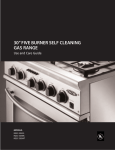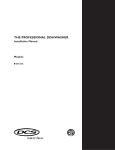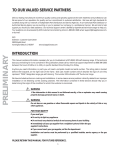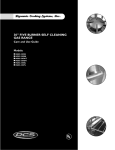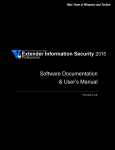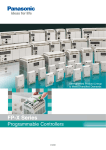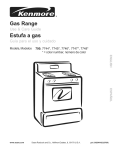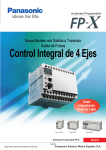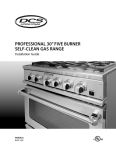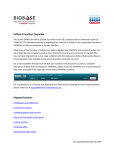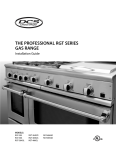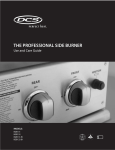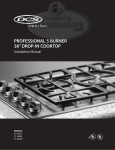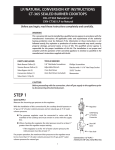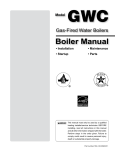Download DCS BGS-1230 Installation manual
Transcript
PROFESSIONAL 30” SELF CLEAN GAS RANGE Installation Manual MODELS: ■ ■ ■ RGSC-305SS RGSC-305BK RGSC-305WT NOTE TO INSTALLER The DCS Professional series of Ranges and Cooktops are designed with a large number of features available in a multitude of different combinations. For your convenience, product questions can be answered by a DCS Customer Service Representative by phone: 1-888-281-5698, or Fax: 714-372-7004, or email: [email protected] or by mail: DCS Attention: Customer Service 5800 Skylab Road, Huntington Beach, CA 92647 www.dcsappliances.com WARNING If the information in this manual is not followed exactly, a fire or explosion may result causing property damage, personal injury or death. PRECAUTION Do not store or use gasoline or other flammable vapors and liquids in the vicinity of this or any other appliance. FOR YOUR SAFETY If you smell gas: Do not try to light any appliance. Do not touch any electrical switch; do not use any phone in your building. Immediately call your gas supplier from a neighbor’s phone. Follow the gas supplier’s instructions. Installation and service must be performed by a qualified installer, service agency or the gas supplier. PLEASE RETAIN THIS MANUAL FOR FUTURE REFERENCE. 1 TABLE OF CONTENTS PLANNING THE INSTALLATION Important Installation Information...................................................................................................................3 Recommended Installation Instructions ........................................................................................................4 VENTILATION REQUIREMENTS Step 1: Ventilation Requirements .....................................................................................................................4 CABINET PREPARATION Step 2: Cabinet Preparation.............................................................................................................................5-6 UNPACKING AND HANDLING Step 3: Unpacking, Moving and Placing the Range................................................................................7-8 ELECTRICAL/GAS CONNECTIONS Step 4: Electrical Connections.............................................................................................................................9 Step 5: Gas..................................................................................................................................................................9 HOOKUP TO GAS SUPPLY Step 6: Hookup.......................................................................................................................................................10 ANTI-TIP DEVICE INSTALLATION Step 7: Anti-tip Device Installation .................................................................................................................11 BACKGUARD INSTALLATION Step 8: Backguard Installation..........................................................................................................................12 FLAME CHARACTERISTICS Step 9: Proper Flame Sizes ..........................................................................................................................12-13 CLEANING EXTERIOR SURFACES Step 10: Cleaning Exterior Surfaces ...............................................................................................................13 INSTALLER FINAL CHECKLIST .........................................................................................................................14 WARRANTY .......................................................................................................................................................................15 SERVICE.................................................................................................................................................................................16 2 PLANNING THE INSTALLATION IMPORTANT INSTALLATION INFORMATION The RGSC-305 is tested in accordance with ANSI Z21.1 Standard for Household Cooking Gas Appliances. The range must be installed in conjunction with a suitable overhead vent hood. (See Step 1 for ventilation requirements, page 4). Due to the professional high heat capacity of this unit, particular attention should be paid to the hood and duct work installation to ensure it meets local building codes. To eliminate risk of burns or fire by reaching over heated surface units, cabinet storage located above the surface units should be avoided. All range models with less than a 12” clearance between combustable material and the back edge of the range, require the installation of one of the two offered Wall Mount Backguards. Wall Mount Full Backguard (Model No. BGS-3030) 1-5/16” 28-1/8” Wall Mount Low Backguard 10-1/8” (Model No. BGS-1230) 1-5/16” FIG. 2 FIG. 1 Check local building codes for the proper method of range installation. Local codes vary. Installation, electrical connections, and grounding must comply with all applicable codes. In the absence of local codes, the range / cooktop should be installed in accordance with the National Fuel Gas Code ANSI Z223.1-1988 and National Electrical Code ANSI / NFPA 70-1990. Be sure that the unit being installed is set up for the kind of gas being used. The gas range is shipped from the factory set and adjusted for Natural Gas or LP (propane), depending on the specific model ordered. Verify that the range is compatible with the gas at the installation site before proceeding further. Return range to dealer if the unit is not set for site gas supply. 3 PLANNING THE INSTALLATION Recommended Installation Instruction (when using BGS-3030 Backguard) Install components in the following order: a. Vent Hood b. Backguard System c. Range 1. Locate and level range according to Range installation instructions. 2. Measure distance from floor to top of island trim on range adding 1/8” for backguard clearance. 3. Transfer this measurement to the wall. This will mark the bottom of your backguard. 4. From this line measure 28-1/8” up wall to mark top of 30” backguard. This is the minimum height that the bottom of your vent hood can be installed. 5. Follow vent hood manufacturer’s installation instructions to install vent hood. 6. Follow backguard installation instructions to install backguard. 7. Connect gas and electric connections and slide range into position. VENTILATION REQUIREMENTS STEP 1: VENTILATION REQUIREMENTS A suitable exhaust hood must be installed above the range / cooktop. The following chart indicates the minimum blower capacity recommended for hood ventilation. VENTILATION UNIT HOOD BLOWER STANDARD COUNTER INSTALLATION RECOMMENDATIONS ISLAND INSTALLATION RECOMMENDATIONS (24” Deep x Unit Width) (30” Deep x 36” at Bottom) 600 CFM (min.) 600 CFM (min.) CAUTION: Ventilation hoods and blowers are designed for use with single wall ducting. However, some local building codes or inspectors may require double wall ducting. Consult local building codes and/or local agencies, before starting, to ensure that hood and duct installation will meet local requirements. Hood blower speeds should be variable to reduce noise and loss of heated or air conditioned household air when maximum ventilation is not required. For best smoke elimination, the lower edge of the hood should be installed a minimum of 30" to a maximum of 36" above the range cooking surface (See Fig. 3, page 5). If the hood contains any combustible materials (i.e. a wood covering) it must be a minimum of 36" above the cooking surface. Due to a high volume of ventilation air, a source of outside replacement air is recommended. This is particularly important for tightly sealed and insulated homes. A reputable heating and ventilating contractor should be consulted. 4 CABINET PREPARATION STEP 2: CABINET PREPARATION 1. The range is a free standing unit. If the unit is to be placed adjacent to cabinets, the clearances shown in Fig. 3 are required. The same clearances apply to island installations . 2. The range can be placed in various positions with respect to the cabinet front, with the front either flush or projecting, depending on the countertop depth (See Fig. 5, page 6). min. 30" wide hood B 12" min. to combustible material , each side A CAUTION: 36" min. to combustible material , from cooking surface D C cooking surface F E electrical + gas supply 35-3/8" max. for level counter, 36-3/4" max. with range leveling legs fully extended A) B) C) D) E) F) As defined in the “National Fuel Gas Code” (ANSI Z223.1, latest edition). The range height is adjustable. The level of the range top must be at the same level or above the countertop level. FIG. 3 ! Flex Line to Range 2" Maximum Protrusion from Wall for Gas Supply FIG. 4 5 7-1/2" 18" min. 3" 13" max. 4-1/2" (gas) 11" (electrical) CABINET PREPARATION 3. The gas and electrical supply should be within the zones shown in Fig. 3 & Fig. 4, page 5. 4. The maximum depth of over head cabinets installed on either side of the hood is 13". 5. Any openings in the wall behind the range and in the floor under the range must be sealed. 6. When there is less than a 12" clearance between combustible material and the back edge of the range, (above the cooking surface) a DCS Backguard must be installed (see Fig. 5). The range comes equipped with Island Trim as standard. Fig. 5 indicates the space required for each type of backguard. 7. Always keep the appliance area clear and free from combustible materials, gasoline and other flammable vapors and liquids. 8. Do not obstruct the flow of combustion and ventilation air to the unit. A Dimensions: B E L O I F G H H B 0” clearance 0” clearance J M N K FIG. 5 6 A) B) E) F) G) H) I) J) K) L) M) N) O) 29-7/8" 35- 3/4" – 37" 27-1/2" 28-1/8" full backguard 10-1/8" low backguard 2" island trim 1-5/16" 30" 44-5/8" 36" min. to combustibles 24-1/4" 26-3/4" 12" min. to combustibles UNPACKING AND HANDLING STEP 3: UNPACKING, MOVING AND PLACING THE RANGE CAUTION: PROPER EQUIPMENT AND ADEQUATE MANPOWER MUST BE USED IN MOVING THE RANGE TO AVOID DAMAGE TO THE UNIT OR THE FLOOR. THE UNIT IS HEAVY AND RESTS ON ADJUSTABLE STEEL LEGS. WARNING: DO NOT LIFT THE RANGE BY THE OVEN DOOR HANDLES !! The range has a shipping weight of approximately 408 pounds or 354 pounds after removal of packing materials. It is recommended that the door, grates and front kick panel be removed to facilitate handling. This will reduce the weight to about 230 pounds. It may be necessary to remove the oven doors and knobs to pass through some doorways. With the doors and knobs removed, a 29-3/8” wide opening is required. Without removing the door, a 30”wide opening is required. Kick Panel FIG. 6 Shipping Spacer Remove the outer carton and packing material from the shipping base. FIG. 7 CAUTION: Before using range, be sure to remove shipping spacer insert in broiler (See Fig. 7). Remove the kick panel by removing two screws at the top and pulling forward. The range is held to the skid by two brackets in the front behind the kick panel (See Fig.6) and two L-brackets located on the bottom flange of the range back (See Fig. 8). After removing the screws and brackets,the range must be lifted and removed from the skid. Due to the weight, a dolly with soft wheels should be used to move this unit. The weight must be supported, uniformly across the bottom (See Fig. 9, page 8). 7 Left Rear Shipping Screws FIG. 8 UNPACKING AND HANDLING To remove the door, open the door and hold it all the way open. Close the hinge latches (See Fig. 10) and release the door. The door can then be removed by gently lifting and pulling the door, with the hinges up and out of the frame. Range Must be Uniformly Supported on Braces The professional range should be transported by a dolly close to its final location. The range can be tipped back and supported on the rear legs while the dolly is removed. The floor under 22" the legs should be protected (wood strips, carpet, paneling,etc.) before Leveling Legs pushing the unit back into position. Electric and gas connections should be made (Steps 4, 5 & 6), the anti-tip device FIG. 9 installed (Step 7), and the backguard installed (Step 8) before the range is placed in its final position. If the unit is to be converted to LP gas, it can be done with the range in place (See page 10). For proper performance, the professional range should be level. To achieve a flush fit of the range to adjoining countertops, it will be necessary to have level cabinets (front to back, and left to right across the opening of the range). After checking the countertops for level and before sliding the range into place, measure the distance from the floor to the top of the counter work surface in the rear left and right corners. Adjust the DOOR HINGE ROLLER corresponding rear corner of the range to an equal height of the counter, as the rear leveling legs are not accessible once the range is pushed into place. Once the range is in place, the front leg levelers can be accessed to level the front of the range. Replace the kick panel and oven doors by reversing the procedure described previously. It is important that the two screws retaining the kick panel are secure to prevent accidental access to live electrical components and wires (See Fig. 6, page 7). LOCK (CLOSE) UN-LOCK NOTE: For ease of installation, be sure to install vent hood and backguard system before sliding range into position. FIG. 10 8 ELECTRICAL/GAS CONNECTIONS STEP 4: ELECTRICAL CONNECTIONS POWER REQUIREMENTS Receptacle Box Cover Plate 120 VAC, 60 Hz., single phase. 4 Amp. Max. (Use 15 Amp. Circuit) Always disconnect electric supply cord from the wall outlet or service disconnect before servicing this appliance. Observe all governing codes and ordinances when grounding, in the absence of which, observe National Electrical Code ANSI/NFPA No. 70-1990. Three Prong Plug Three Prong Receptacle FIG. 11 RECOMMENDED GROUNDING METHOD This appliance is factory equipped with a power supply cord with a three-prong grounding plug (with polarized parallel blades). It must be plugged into a mating grounding type receptacle, connected to a correctly polarized 120 Volt circuit. If the circuit does not have a grounding type receptacle, it is the responsibility and obligation of the installer or user to have the existing receptacle changed to a properly grounded and polarized receptacle in accordance with all applicable local codes and ordinances by a qualified electrician. In the absence of local codes and ordinances, the receptacle replacement shall be in accordance with the National Electrical Code. THE THIRD GROUND PRONG SHOULD NOT, UNDER ANY CIRCUMSTANCES, BE CUT OR REMOVED (See Fig. 11). STEP 5: GAS Verify the type of gas supplied to the location. The range is shipped from the factory set up and adjusted for natural gas or LP (propane), depending on specific model ordered. The unit cannot be converted. NATURAL GAS REQUIREMENTS Connection: 1/2" N.P.T. Minimum 5/8" dia. flex line. Pressure: 6" to 14" W.C. L.P. GAS REQUIREMENTS Connection: 1/2" N.P.T. Minimum 5/8" dia. flex line. Pressure: Supply pressure must be 11" to 14" W.C. A regulator is required at the L.P. source to provide a maximum of 14" W.C. to the range regulator. 9 HOOKUP TO GAS SUPPLY STEP 6: HOOKUP A manual valve is installed in an accessible location from the front for the purpose of shutting off the gas supply. The supply line must not protrude beyond the back of the unit. Make sure the gas supply is turned off before connecting the appliance. The flex line for the gas supply must be metal and be approved by CSA, AGA, CGA OR UL. Only use a metal supply hose, as the heat may cause a rubber hose to melt and develop leaks. The gas supply connections should be made by a qualified technician and in accordance with local codes or ordinances. In the absence of a local code, the installation must conform to the National Fuel Gas Code ANSI 223.1-1988, latest edition. CAUTION: The appliance must be isolated from the building’s gas supply piping system by closing its individual manual shut-off valve during any pressure testing of the gas supply piping system at test pressures equal to or less than 1/2 psig (3.5kPa.) The appliance and its individual shut-off valve must be disconnected from the gas supply piping system during any pressure testing of the system at the test pressures in excess of 1/2 psig (3.5kPa.). When checking the manifold gas pressure, the inlet pressure to the regulator should be at least 7.0”W.C. for natural gas or 12.0” for LP. When hooking up the gas supply from range rear hard pipe to wall hard pipe, installation length of flex line between range/wall hard piping must accommodate the range being pulled from wall for cleaning or servicing purpose. When range is pulled from wall, no strain should occur at range or wall hard pipe connections (See Fig. 12 below). Manual Shut-Off Valve must be Easily Accessible Hard Pipe 1/2" NPT Metal Flex Gas Line FIG. 12 10 W AL Ha L conrd P nec ipe tio n ANTI-TIP DEVICE INSTALLATION INSTRUCTIONS STEP 7: ANTI-TIP DEVICE INSTALLATION All ranges must have an anti-tip device correctly installed as per these instructions. If you pull the range out from the wall for any reason, make sure that the device is properly engaged when you push the range back against the wall. If it is not, there is a possible risk of the range tipping over and causing injury if you or a child stand, sit or lean on an open door. INCLUDED PARTS: (2) Wood Screws into Back Wall (ALL Installations) Included with this kit are: (4) #10 x 2” wood screws, (1) Anti-tip bracket, and (1) Installation Instructions. (2)Small Holes for Wood Installations INSTALLING THE KIT: Instructions are provided for wood and cement floors. Any other type or construction may require special installation techniques as deemed necessary to provide adequate fastening of the Anti-tip bracket to the floor and wall. The use of this bracket does not preclude tipping of the range when not properly installed. BACK WALL (2) Large Holes for Concrete Installations OF E IDE ANG S HT R R RIG LL O WA 3/4” WOOD CONSTRUCTION: FIG. 13 Place the bracket against the back wall, into the right rear corner where the range is to be located. Leave a gap between the wall (or side of range) and the bracket of 3/4”. Drill (2) 1/8” diameter pilot holes in the center of the small holes. A mail or awl may be used if a drill is not available. Fasten the bracket securely to the floor and wall. See Fig. 13. CONCRETE OR CEMENT CONSTRUCTION: HARDWARE REQUIRED: (2) sleeve anchors, lag bolts, and washers (not provided). Locate the bracket as described above. Drill the recommended size holes for the hardware. Install the sleeve anchors into the holes and then install the lag bolts through the bracket. The bolts must be properly tightened as recommended for the hardware. Fasten the bracket securely to the floor and wall. WARNING ALL RANGES CAN TIP INJURY COULD RESULT INSTALL ANTI-TIP BRACKET PACKED INSIDE OVEN SEE INSTRUCTIONS ONCE INSTALLED: Complete the range installation per the instructions provided with the product. Check for proper installation of the Range and Anti-tip device by grasping the back of the unit and carefully attempt to tilt the range forward. 11 BACKGUARD INSTALLATION STEP 8: BACKGUARD INSTALLATION The backguard must be installed when there is less than a 12" clearance between combustibles and the back of the range (above the cooking surface) (See Fig. 3, page 5). Wall Mount Full Backguard (30”) (Model No. BGS-3030) Wall Mount Low Backguard (12”) (Model No. BGS-1230) BACKGUARD KITS: The backguard is located, as shown in Fig. 14. Secure the backguard to the wall behind the range. Specific instructions for installation of the full backguard or low backguard can be found packaged with the backguard. FIG. 14 FLAME CHARACTERISTICS STEP 9: PROPER FLAME SIZES INFRARED BROIL BURNER OVEN BURNER 1-1/2" - 2" BLUE FLAME FIG. 16 FIG. 15 COOKTOP BURNER SEALED TOP BURNER LIGHTING NOTE: 1-1/2" The sealed top burners have an infinite number of heat settings and there are no fixed positions on the control knobs between HI and LO. To turn the sealed top burner on, push in on the control knob and turn it counterclockwise to the “LITE” position. An audible clicking sound will be heard. When the gas has been ignited by the electronic spark igniter, turn the knob to the desired setting. FIG. 17 12 FLAME CHARACTERISTICS CAUTION: When turning on any sealed top burner, be sure to stop at the “LITE” position before turning the burner to a flame setting for cooking. If the burner is not lit and it is turned beyond the “LITE” position, to HI, MEDIUM, or LO, there will be a burst of flame when the burner does light. This could cause burns or damage to the surrounding countertop. CAUTION: The oven infra-red broiler burner has no air shutter and is not adjustable.The oven bake burner has an air shutter and is adjustable . It is necessary to operate the oven broiler for 45 minutes to eliminate the harsh odor of the insulation binder. This must be done BEFORE using the range for the first time and with proper ventilation. CAUTION: For Warranty coverage, DCS requires that burner adjustments be made by a qualified technician at the time of installation.Extreme care should be used when adjustments are made after installation. Improper or lack of adjustments will void your warranty. Check for the proper burner flame characteristics (See Figs. 15-17, page 12). Burner flames should be blue and stable with no yellow tips, excessive noise or lifting of the flame from the burner. If any of these conditions exist, check that the air shutter (oven burner only) or burner ports are not blocked. If this condition persists, contact a qualified technician. The sealed top burner flames should be approximately 1-1/2" high. The oven burner flames should be 1-1/2" to 2". The infrared broil burner flames should be approximately 1/8” high over the entire burner screen (See Figs. 15-17, page 12). CLEANING EXTERIOR SURFACES STEP 10: CLEANING EXTERIOR SURFACES The stainless steel surfaces may be cleaned by wiping with a damp soapy cloth. Any mild glass cleaner will remove fingerprints and smears. Do not use steel wool as it will scratch this surface. Small scratches may be removed by lightly sanding with the grain, using 200 grit paper. 13 INSTALLER FINAL CHECKLIST GENERAL Placement of Unit. Specified clearance maintained to cabinet surfaces. Unit Level- front to back, side to side. All packaging material and tie straps removed, drip pans clean and empty. Backguard wall system installed if there is less than 12" clearance above the cooking surface to combustibles behind unit. ELECTRICAL Receptacle with 15 ampere over-current protection is provided for service cord connection. Adequate ground connection. Kick panel (See Fig. 6, page 7) in place and two (2) screws secure. GAS SUPPLY Connection: 1/2 NPT with a minimum 5/8" diameter metal flex line. The pressure regulator which is connected to the manifold is set for 5.0" W.C. for natural gas or 10.0” W.C. for LP. Manual gas shut off valve installed in an accessible location. Unit tested and free of gas leaks. OPERATION All internal packing materials removed. Check below grate and inside oven. Bezels centered on burner knobs and knobs turn freely. Each burner lights satisfactorily, both individually and with other burners operating at the same time. Check flame characteristics on all burners and adjust as specified per instructions on page 12 (See Figs. 15-17, page 12). Oven door hinges seated and door opens and closes properly. Burner grates correctly positioned, level, and do not rock. 14 WARRANTY LENGTH OF WARRANTY One (1) Year Full – Covers the entire product Five (5) Years Limited – Surface burners, Oven burner Ten (10) Years Limited – Porcelain oven, Porcelain inner door panel DCS WILL PAY FOR: All repair labor and replacement parts, for parts found to be defective due to materials or workmanship. Service must be provided by Authorized Factory Agent during normal working hours. DCS WILL NOT PAY FOR: Installation or start-up. Shipping damage. Service by an unauthorized agency. Damage or repairs due to service by an unauthorized agency or the use of unauthorized parts. Service during other than normal working hours. Improper installation, such as improper hook-up, etc. Service visits to teach you how to use the appliance; correct the installation; reset circuit breakers or replace home fuses. Repairs due to other than normal house hold use. Damage caused from accident, abuse, alteration, misuse, incorrect installation or installation not in accordance with local codes. Units installed in non-residential application such as day care center, bed and breakfast centers, churches, nursing homes, restaurants, hotels, schools, etc. This warranty applies to appliances used in residential applications; it does not cover their use in commercial situations. This warranty is for products purchased and retained in the 50 states of the U.S.A., the District of Columbia and Canada. This warranty applies even if you should move during the warranty period. Should the appliance be sold by the original purchaser during the warranty period, the new owner continues to be protected until the expiration date of the original purchaser’s warranty period. This warranty gives you specific legal rights. You may also have other rights which vary from state to state. 15 SERVICE HOW TO OBTAIN SERVICE: For warranty service, contact DCS Customer Service at (888) 281-5698. Before you call, please have the following information ready: Model Number Serial Number Date of installation A brief description of the problem Your satisfaction is of the utmost importance to us. If a problem cannot be resolved to your satisfaction, please write or fax or email us at: Write: DCS Attention: Customer Service 5800 Skylab Road Huntington Beach, CA 92647 Fax: (714) 372-7004 Email: [email protected] BEFORE YOU CALL FOR SERVICE: 1. Is the circuit breaker tripped or the fuse blown? 2. Is there a power outage in the area? 16

















